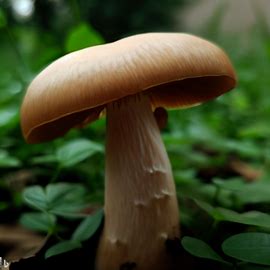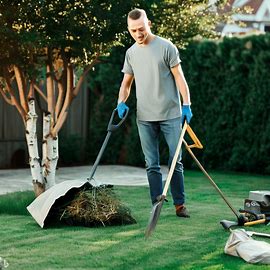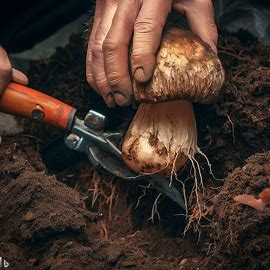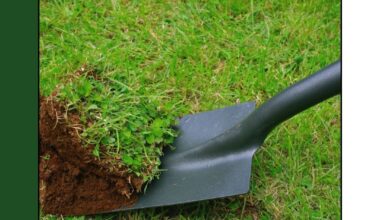Let’s talk mushrooms–those unexpected invaders popping up overnight. While some view them as funky fungus adding charm to their plant haven, others may see them as unwanted gatecrashers at an otherwise perfect garden party. If you’re part of the latter group, don’t fret! We’ve got a game plan for you.
Mushrooms thrive in moist conditions and feed off natural decay in your soil or mulch – it’s like they’ve found their own personal all-you-can-eat buffet! However, these fungi can be booted out just as swiftly as they appeared.
So how do we put a halt to this mushroom invasion? You don’t need magical potions or ancient incantations—just some good old-fashioned gardening elbow grease! By the end of this guide, you’ll be poised to take on any pesky shroom that dares sprout in your patch with confidence and aplomb!
Identifying the Type of Mushrooms in Your Garden

When it comes to stopping mushrooms from growing in your garden, one of the first steps is to identify the specific type of mushrooms you’re dealing with.
Not all mushrooms are harmful or unwanted, so knowing which ones are causing problems will help you target your prevention efforts more effectively.
Take a close look at their size, shape, and color. If you’re unsure about their identification, consult a local expert or use online resources for guidance.
Sealing Off Possible Mushroom Spawning Areas
Prevention is key when it comes to keeping mushrooms at bay. One way to do this is by sealing off areas where mushroom spores can thrive and spread.
Start by identifying any decaying organic matter such as wood chips or old mulch that may be providing a fertile ground for mushroom growth.
Remove these materials and replace them with fresh mulch or gravel, which reduces moisture retention and makes it less conducive for fungi colonization.
Drying Out and Providing Adequate Sunlight to Damp Areas
Mushrooms love damp and shaded environments – by drying out these areas through proper drainage techniques and increasing sunlight exposure, you can discourage their growth.
Improve soil drainage by incorporating organic matter like compost into heavy clay soils or creating slopes away from problem areas.
Additionally, consider trimming back overgrown plants or trees that may be casting shadows on susceptible spots in your garden.
Proper Lawn Maintenance and Cleaning Debris Regularly

Maintaining a clean garden not only enhances its aesthetic appeal but also reduces the chances of mushroom infestation.
Regularly remove fallen leaves, dead plant material, sticks, weeds, and any other debris that accumulate on your lawn as they provide an ideal breeding ground for fungi.
By keeping your garden clean and tidy, you’ll limit the available nutrients that mushrooms need to grow.
Balancing Soil pH Level for Unfavorable Mushroom Growth
The pH level of your soil can significantly impact mushroom growth. Most mushrooms prefer a slightly acidic environment, so optimizing soil pH levels can help deter their proliferation.
Test your soil using a pH testing kit, easily obtained from gardening centers or online stores. If the results indicate an overly acidic environment, consider adding lime to raise the pH and create an inhospitable condition for unwanted mushrooms.
Controlling Watering Schedules to Prevent Excess Moisture
Proper watering is essential for plant health but overwatering can create excessive moisture that fosters mushroom growth.
To prevent this, establish a regular watering schedule that allows moisture to evaporate between waterings – aim for watering in the morning rather than late afternoon or evening when evaporation rates are slower due to cooler temperatures and higher humidity levels.
Using Fungicides Appropriately as a Last Resort Solution
While preventing mushroom growth through natural methods is preferred, there may be instances where more aggressive measures are necessary.
Fungicides can be used as a last resort solution if other prevention techniques have failed or if you’re dealing with persistent fungal infestations in your garden.
However, it’s crucial to follow the instructions on the product label carefully and only use fungicides approved for garden use.
Companion Planting for Suppressing Mushrooms
Strategic planting of certain companion plants can help suppress mushroom growth by creating unfavorable conditions for fungi presence.
Plants such as marigolds, petunias, garlic chives, and lavender release chemicals into the soil that act as natural fungicides or repellents against mushroom spores.
Removal of Established Mushrooms from the Root

When mushrooms have already established themselves in your garden, it’s important to remove them properly to prevent further spore dispersal.
Use a small gardening knife or trowel to dig around the base of the mushroom and gently lift it from the ground.
Be sure to remove as much of the root system as possible to minimize regrowth.
Biochemical Prevention Measures Against Fungi Spores
Certain biofungicides can be used as prevention measures against fungi spores in your garden. These natural compounds contain beneficial microorganisms that help suppress fungal growth by out-competing them for nutrients or attacking their cell walls.
Look for biofungicides containing Bacillus subtilis or Streptomyces lydicus, which are effective against a wide range of plant pathogens.
Improving Grass Health as Natural Competitors for Nutrients
Maintaining healthy grass is another way to naturally compete with mushrooms for nutrients and limit their growth.
Ensure proper lawn care practices such as regular mowing at the appropriate height, aerating annually, and fertilizing based on soil test results.
By establishing strong grass cover, you create an environment where mushrooms struggle to thrive due to increased competition for resources.
Non-chemical Alternatives to Stop Mushroom Growth
If you prefer non-chemical approaches or want more sustainable options, there are several alternatives available.
Sprinkling crushed oyster shells or cinnamon around problem areas can help deter mushroom growth due to their antifungal properties.
Additionally, using cornmeal as a top dressing not only feeds beneficial microbes but also helps control fungi populations in the soil naturally.
Conclusion
Preventing unwanted mushroom growth in your garden requires a combination of proactive measures and consistent maintenance practices.
By following this step-by-step guide and implementing these strategies tailored specifically to your garden’s needs, you’ll be able to keep those pesky mushrooms at bay and enjoy a healthy, fungi-free outdoor space.
Remember, it’s all about maintaining the right balance of sunlight, moisture, and soil conditions while incorporating natural deterrents that discourage mushroom infestations.
Happy gardening!

